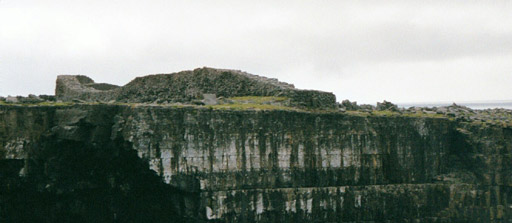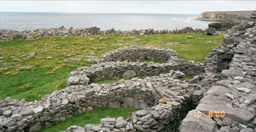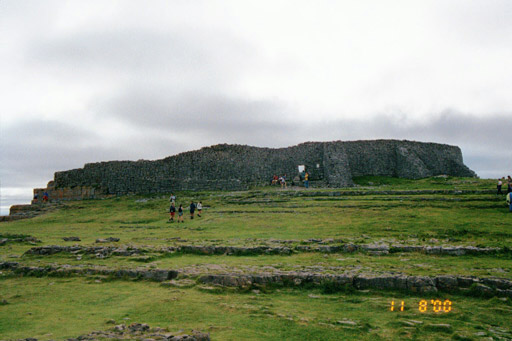
The Aran Islands were a stronghold of Celtic chieftains during the Iron Age, and during this time the islanders built many monumental structures from the most abundant local material: the stones of the island. Some of these forts have survived almost untouched through the millenia, while others were partially or totally destroyed, and have been restored through the efforts of 19th or 20th century archaeologists.
Historians think that the forts shown here were built about two thousand years ago, around the time of the birth of Christ. However, recent archaeological excavations have shown that the forts were built upon even older habitations, so the sites, especially Dún Aonghasa, have been in use for more than three thousand years.

Located on a promontory on the southern coast of Inis Mór, the "Black Fort" is surrounded on three sides by a sheer drop of almost one hundred feet. At the bottom of the cliffs, the waters of the Atlantic pound against bare stone blocks. Anyone approaching this structure has no choice but to follow the natural paths through the surrounding terrain of exposed rock. Pointed stones wedged into the natural cracks of the limestone create an even greater impediment to anyone approaching. Obviously a very defensible location, this might have served as a final place of refuge if the islands were invaded.

The interior of the fort is more hospitable than one might expect. Note the bright green of the grass in the lower left of this picture. The five-foot-thick stone ring surrounds a natural bowl, where lush grass is watered by the frequent mists of fog and low-flying clouds that blow in from the ocean. Several freshwater springs can also be found in the surrounding cliffs. People taking refuge here could bring with them a few sheep, goats, or small cattle, which could graze here and provide a well-managed food supply. The walls at left, within the main ring, are the conjoined walls of stone houses, probably from the late medieval period.

Dún Aonghasa as seen from the highest point on the island.
The largest and most famous of the Aran Islands' stone forts, Dún Aonghasa is also one of the more mysterious. Recent investigations show that this was probably the first of the fort sites on the Arans to be occupied. The first semicircular stone defensive wall may have been erected as early as 1100 BC. Evidence of human occupation of the site dates from even earlier, although it is not known whether these prehistoric occupants used the site on a permanent basis, or only visited from time to time. The site's current design, with the triple wall and protecting stone outcroppings, dates to the period between 500 and 900 AD.
The fort today consists of three concentric, semi-circular stone walls atop one of the highest cliffs on the island. In the middle of the innermost ring, a platform of stone juts out above a 300-foot drop to the sea (I thought that this was a natural formation when I first saw it, but it was actually created by the quarrying of the stone around it, which was used to make the surrounding walls). Like the Black Fort, this location would have been difficult to access and easy to defend, but its rocky interior is hundreds of yards from any fresh water source. Undoubtedly people did live in Dún Aonghasa, as the remains of household articles as well as the bones of children, adults, and animals have been excavated here. Its location, where the Atlantic cliffs are at their highest, would have made it an ideal lookout point for the entire southwestern coast of Ireland. On a clear day, one can see as far north as the mountains of Connemara, and as far south as Mount Brandon in County Kerry.
Some historians speculate that, rather than a military stronghold, this "fort" may have been primarily used for religious purposes. The argument is compelling, especially when one sees the altar-like central stone platform within the innermost ring, looking out over the very edge of the sea cliffs. Perhaps ancient Celtic priests once stood atop it and worshiped the unfathomable forces of the ocean, with its powerful storms and mighty waves that had such influence over the destiny of the island people. Unfortunately, all the voices that could have told us the true story are long silent.

Click here to return to the Index of Pictures.
Click here to return to the Slackwood Home Page.